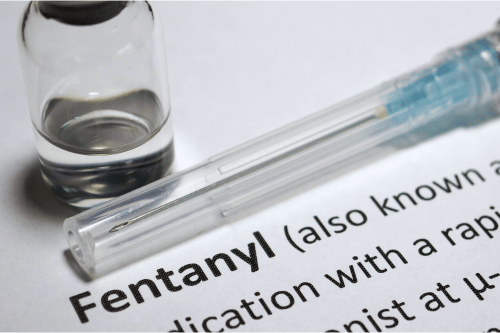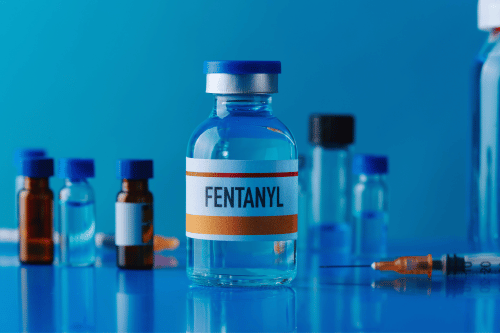

Fentanyl is a powerful synthetic opioid with a high potential for addiction and dependence. Due to its rapid onset and short half-life, withdrawal from fentanyl can be intense. Understanding the fentanyl withdrawal timeline helps prepare individuals for the symptoms and the need for medical support during this critical phase of recovery.
Fentanyl withdrawal occurs when a person who is physically dependent on fentanyl stops using it. The body reacts to the absence of the drug, resulting in a range of physical and psychological symptoms. These symptoms often resemble those of other opioid withdrawal syndromes but may appear faster and with greater intensity due to fentanyl’s potency.
Frequent fentanyl use leads to physical dependence as the body adapts to the presence of the drug. When use stops, the brain struggles to balance itself, causing opioid withdrawal symptoms. The severity of withdrawal symptoms often depends on the dosage, length of use, and the presence of other synthetic opioids in the system.
Fentanyl is a short-acting opioid, so withdrawal symptoms can begin as soon as six hours after the last dose. Early signs often include runny nose, yawning, anxiety, and restlessness. Individuals may also notice dilated pupils and an increased heart rate during this initial stage of withdrawal.
The first 72 hours bring the most acute withdrawal symptoms. People often experience muscle aches, bone pain, abdominal cramps, and severe pain. Psychological symptoms like depression, irritability, and anxiety also worsen, making this the most difficult stage of withdrawal from fentanyl.
After the peak, many physical symptoms begin to ease, although stomach cramps, sweating, and fatigue may linger. Psychological symptoms of opioid withdrawal can persist longer and may require behavioral therapy. Cravings can remain strong, emphasizing the need for a structured treatment plan.
While many symptoms subside after one week, some may continue experiencing insomnia, mood swings, and lingering fatigue. This stage of withdrawal highlights the importance of long-term recovery strategies. Working with a medical professional during this phase can help reduce the risk of relapse.

Several factors impact the duration of fentanyl withdrawal symptoms, including individual metabolism and history of opioid use disorders. Whether someone used prescription opioids or illicit fentanyl also matters. People with chronic pain or co-occurring mental health issues may experience longer and more severe withdrawal periods.
Fentanyl withdrawal symptoms include muscle aches, runny nose, abdominal cramps, and bone pain. Additional physical symptoms like dilated pupils, chills, and increased heart rate are also common. These uncomfortable withdrawal symptoms are signs the body is adjusting to the absence of the drug.
Psychological symptoms may include anxiety, depression, and irritability. Some individuals may also struggle with insomnia or intense cravings. These psychological effects are just as challenging as physical ones and require medical treatments and counseling support.
Fentanyl detox should take place under medical supervision. Withdrawal can lead to severe symptoms, and attempting detox alone increases the risk of complications. Medical professionals monitor the heart rate, treat abdominal cramps, and help manage severe withdrawal symptoms safely.
Medical detox helps manage opioid withdrawal symptoms and reduces health risks. Facilities like Sullivan Recovery in Mission Viejo provide medical detox and 24/7 care. Detox is the first step toward recovery and helps ensure individuals are stable enough to begin long-term treatment.
MAT uses medications such as opioid agonists to reduce cravings and withdrawal symptoms. These treatments are effective for managing physical dependence and reducing the risk of overdose. MAT can include long-acting opioids like methadone or buprenorphine.
Psychological symptoms need ongoing support beyond detox. Behavioral therapy helps individuals manage cravings, emotional stress, and mental health symptoms. At Sullivan Recovery, we incorporate therapy into our outpatient addiction treatment programs to support long-term healing.

After detox, individuals lose their tolerance, increasing the risk of overdose if they relapse. This makes post-detox care vital in preventing fatal outcomes. Education about the potential for addiction and safe recovery practices helps reduce this danger.
Fentanyl withdrawal is only the beginning of the recovery journey. A comprehensive treatment plan should address substance use disorders, mental health, and relapse prevention. Sullivan Recovery offers a range of addiction treatment programs tailored to each person’s needs.
After medical detox, many benefit from outpatient care. Outpatient programs allow people to receive continued treatment while resuming daily life. At Sullivan Recovery, we help clients build structure and routine while focusing on recovery.
Opioid use disorders require ongoing care, not just short-term detox. Long-term recovery includes managing triggers, learning coping strategies, and attending therapy. Our team works with clients to develop a lasting treatment plan and reduce the chance of relapse.
Many individuals with fentanyl addiction also struggle with chronic pain or untreated mental health conditions. These must be treated alongside the substance use to ensure effective treatment. We work closely with healthcare professionals to offer full-spectrum care.

Synthetic opioids like fentanyl are much more potent than prescription opioids. The rapid onset and strength increase the risk of physical dependence and overdose. Understanding the effects of synthetic opioids is essential for developing effective treatment options.
At Sullivan Recovery in Orange County, we help individuals through each stage of fentanyl withdrawal and recovery. From fentanyl detox to outpatient support, we offer medical supervision and evidence-based care. Our team includes licensed medical professionals and therapists who guide clients through the withdrawal process and beyond.
If you’re experiencing symptoms of opioid withdrawal or relying on fentanyl to function, it may be time to seek help. Other signs include severe withdrawal symptoms when not using, increased tolerance, and difficulty stopping despite consequences. Early treatment lowers the risk of overdose and leads to a healthier life. You may also notice physical symptoms such as runny nose, muscle aches, or abdominal cramps during periods of non-use—these are clear signs of developing opioid dependence. If left untreated, fentanyl addiction can progress quickly, especially with the presence of illicit fentanyl or other synthetic opioids in your system.
Withdrawing from fentanyl without help can be dangerous. A medical professional can monitor the severity of withdrawal symptoms, provide medication, and support a safe detox. At Sullivan Recovery, we customize care to meet each client’s needs during detox and recovery.
Fentanyl addiction often progresses quickly due to its potency, rapid onset, and short-acting opioid properties. This synthetic opioid creates a high risk of physical dependence, making the withdrawal process more intense and harder to manage without support. Early intervention helps prevent severe withdrawal symptoms, reduces the risk of overdose, and improves the chances of successful recovery.
Recognizing the symptoms of fentanyl withdrawal—such as muscle aches, runny nose, abdominal cramps, and psychological symptoms like anxiety or depression—is a critical first step. These symptoms of withdrawal can escalate quickly and require medical detox under medical supervision. Without timely treatment, the physical and psychological impact of opioid use disorders can become life-threatening.
If you or someone you care about shows signs of fentanyl dependence, it is vital to act immediately. Working with a medical professional ensures that opioid withdrawal symptoms are managed safely through medication-assisted treatments and comprehensive treatment plans. Early intervention leads to more effective treatment, reduces the duration of fentanyl withdrawal, and supports long-term recovery.
We treat opioid use disorders using a combination of medical detox, behavioral therapy, and outpatient treatment. Each treatment plan is built with long-term recovery in mind. Our team understands how opioid withdrawal affects both the body and mind, and we address both for the best outcomes.

Many addiction treatment programs, including medical detox and outpatient care, are covered by popular insurance providers. We help clients verify their coverage for rehab and treatment. Financial support should never be a barrier to getting the help you need.
The fentanyl withdrawal timeline varies by person, but most people face uncomfortable symptoms during the first week. Working with medical professionals ensures the withdrawal process is safe and increases the chances of successful recovery. At Sullivan Recovery in Mission Viejo, we provide effective treatment for fentanyl addiction and help you take the next step toward long-term recovery.
If you or a loved one is struggling with fentanyl dependence, reach out today. We’re here to help you start your recovery journey safely and confidently.
1. Substance Abuse and Mental Health Services Administration (SAMHSA)
URL:https://www.samhsa.gov/medications-substance-use-disorders
2. National Institute on Drug Abuse (NIDA)
https://nida.nih.gov/publications/drugfacts/fentanyl
3. Centers for Disease Control and Prevention (CDC)
https://www.cdc.gov/stopoverdose/fentanyl/
4. MedlinePlus – U.S. National Library of Medicine
At Sullivan Recovery, as an in-network provider we work with most insurance plans, such as:
And More
If you or a loved one are struggling with mental health challenges or substance abuse, reach out to Sullivan Recovery today. Our team of compassionate professionals is here to support your journey towards lasting well-being. Give us a call at 949-836-7180.
While fentanyl withdrawal is usually not life-threatening, it can lead to severe dehydration, heart complications, or mental health crises if unmanaged. The safest option is to detox under medical supervision to reduce serious risks. Medical professionals can provide medications and hydration support to stabilize vital signs.
Fentanyl withdrawal often begins faster and feels more intense than withdrawal from long-acting opioids like methadone. This is due to its short-acting nature and high potency as a synthetic opioid. People addicted to fentanyl may face more severe physical and psychological symptoms than those withdrawing from prescription opioids.
Some over-the-counter remedies may ease mild symptoms like stomach cramps or runny nose, but they cannot manage severe pain, cravings, or psychological symptoms. These symptoms often require prescription medication-assisted treatments. Self-managing withdrawal without guidance from a medical professional can be dangerous.
You can begin treatment immediately after stopping fentanyl, especially if entering a medical detox program. The withdrawal process typically starts within hours, so being under medical supervision from the start improves safety. Treatment for fentanyl addiction should continue after detox with behavioral therapy and outpatient support.